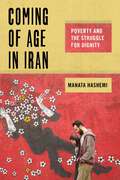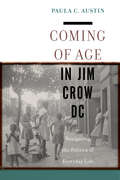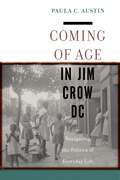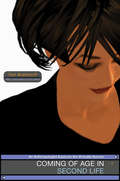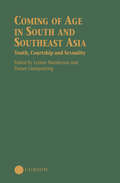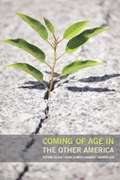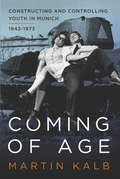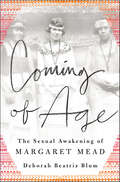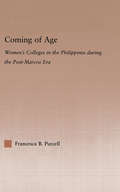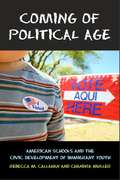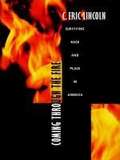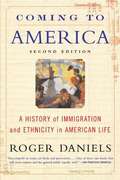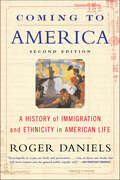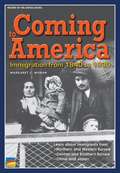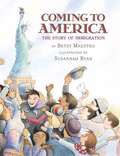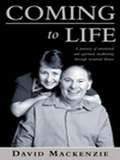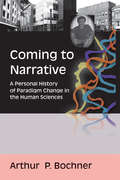- Table View
- List View
Coming of Age in America: The Transition to Adulthood in the Twenty-first Century
by Mary C. Waters Patrick J. Carr Maria J. Kefalas Jennifer HoldawayWhat is it like to become an adult in twenty-first-century America? This book takes us to four very different places--New York City, San Diego, rural Iowa, and Saint Paul, Minnesota--to explore the dramatic shifts in coming-of-age experiences across the country. Drawing from in-depth interviews with people in their twenties and early thirties, it probes experiences and decisions surrounding education, work, marriage, parenthood, and housing. The first study to systematically explore this phenomenon from a qualitative perspective, Coming of Age in America offers a clear view of how traditional patterns and expectations are changing, of the range of forces that are shaping these changes, and of how young people themselves view their lives.
Coming of Age in Chicago: The 1893 World's Fair and the Coalescence of American Anthropology
by David R. Wilcox Ira Jacknis James Snead Curtis M. Hinsley Donald McVickerComing of Age in Chicago explores a watershed moment in American anthropology, when an unprecedented number of historians and anthropologists of all subfields gathered on the 1893 Chicago Columbian Exposition fairgrounds, drawn together by the fair’s focus on indigenous peoples. Participants included people making a living with their research, sporadic backyard diggers, religiously motivated researchers, and a small group who sought a “scientific” understanding of the lifeways of indigenous peoples. At the fair they set the foundation for anthropological inquiry and redefined the field. At the same time, the American public became aware, through their own experiences at the fair, of a global humanity, with reactions that ranged from revulsion to curiosity, tolerance, and kindness. Curtis M. Hinsley and David R. Wilcox combine primary historical texts, modern essays, and rarely seen images from the period to create a volume essential for understanding the significance of this event. These texts explore the networking of thinkers, planners, dreamers, schemers, and scholars who interacted in a variety of venues to lay the groundwork for museums, academic departments, and expeditions. These new relationships helped shape the profession and the trajectory of the discipline, and they still resonate more than a century later.
Coming of Age in Iran: Poverty and the Struggle for Dignity (Critical Perspectives on Youth #6)
by Manata HashemiAn inside look at young Iranians navigating poverty and stigma in a time of crisis Crippling sanctions, inflation, and unemployment have increasingly burdened young people in the Islamic Republic of Iran. In Coming of Age in Iran, Manata Hashemi takes us inside the lives of poor Iranian youth, showing how these young men and women face their future prospects.Drawing on first-hand accounts, Hashemi follows their stories, one by one, as they struggle to climb up the proverbial ladder of success. Based on years of ethnographic research among these youth in their homes, workspaces, and places of leisure, Hashemi shows how public judgments can give rise to meaningful changes for some while making it harder for others to escape poverty. Ultimately, Hashemi sheds light on the pressures these young men and women face, showing how many choose to comply with—rather than resist—social norms in their pursuit of status and belonging.Coming of Age in Iran tells the unprecedented story of how Iran’s young and struggling attempt to extend dignity and alleviate misery, illuminating the promises—and limits—of finding one’s place during a time of profound uncertainty.
Coming of Age in Jim Crow DC: Navigating the Politics of Everyday Life
by Paula C. AustinThe fullest account to date of African American young people in a segregated cityComing of Age in Jim Crow DC offers a complex narrative of the everyday lives of black young people in a racially, spatially, economically, and politically restricted Washington, DC, during the 1930s. In contrast to the ways in which young people have been portrayed by researchers, policy makers, law enforcement, and the media, Paula C. Austin draws on previously unstudied archival material to present black poor and working class young people as thinkers, theorists, critics, and commentators as they reckon with the boundaries imposed on them in a Jim Crow city that was also the American emblem of equality.The narratives at the center of this book provide a different understanding of black urban life in the early twentieth century, showing that ordinary people were expert at navigating around the limitations imposed by the District of Columbia’s racially segregated politics. Coming of Age in Jim Crow DC is a fresh take on the New Negro movement, and a vital contribution to the history of race in America.
Coming of Age in Jim Crow DC: Navigating the Politics of Everyday Life
by Paula C. AustinThe fullest account to date of African American young people in a segregated cityComing of Age in Jim Crow DC offers a complex narrative of the everyday lives of black young people in a racially, spatially, economically, and politically restricted Washington, DC, during the 1930s. In contrast to the ways in which young people have been portrayed by researchers, policy makers, law enforcement, and the media, Paula C. Austin draws on previously unstudied archival material to present black poor and working class young people as thinkers, theorists, critics, and commentators as they reckon with the boundaries imposed on them in a Jim Crow city that was also the American emblem of equality.The narratives at the center of this book provide a different understanding of black urban life in the early twentieth century, showing that ordinary people were expert at navigating around the limitations imposed by the District of Columbia’s racially segregated politics. Coming of Age in Jim Crow DC is a fresh take on the New Negro movement, and a vital contribution to the history of race in America.
Coming of Age in Medieval Egypt: Female Adolescence, Jewish Law, and Ordinary Culture
by Eve KrakowskiMuch of what we know about life in the medieval Islamic Middle East comes from texts written to impart religious ideals or to chronicle the movements of great men. How did women participate in the societies these texts describe? What about non-Muslims, whose own religious traditions descended partly from pre-Islamic late antiquity?Coming of Age in Medieval Egypt approaches these questions through Jewish women’s adolescence in Fatimid and Ayyubid Egypt and Syria (c. 969–1250). Using hundreds of everyday papers preserved in the Cairo Geniza, Eve Krakowski follows the lives of girls from different social classes—rich and poor, secluded and physically mobile—as they prepared to marry and become social adults. She argues that the families on whom these girls depended were more varied, fragmented, and fluid than has been thought. Krakowski also suggests a new approach to religious identity in premodern Islamic societies—and to the history of rabbinic Judaism. Through the lens of women’s coming-of-age, she demonstrates that even Jews who faithfully observed rabbinic law did not always understand the world in rabbinic terms. By tracing the fault lines between rabbinic legal practice and its practitioners’ lives, Krakowski explains how rabbinic Judaism adapted to the Islamic Middle Ages.Coming of Age in Medieval Egypt offers a new way to understand how women took part in premodern Middle Eastern societies, and how families and religious law worked in the medieval Islamic world.
Coming of Age in Nineteenth-Century India
by Ruby LalIn this engaging and eloquent history, Ruby Lal traces the becoming of nineteenth-century Indian women through a critique of narratives of linear transition from girlhood to womanhood. In the north Indian patriarchal environment, women's lives were dominated by the expectations of the male universal, articulated most clearly in household chores and domestic duties. The author argues that girls and women in the early nineteenth century experienced freedoms, eroticism, adventurousness and playfulness, even within restrictive circumstances. Although women in the colonial world of the later nineteenth century continued to be agential figures, their activities came to be constrained by more firmly entrenched domestic norms. Lal skillfully marks the subtle and complex alterations in the multifaceted female subject in a variety of nineteenth-century discourses, which are elaborated in four different sites - forest, school, household, and rooftop.
Coming of Age in Second Life
by Tom BoellstorffMillions of people around the world today spend portions of their lives in online virtual worlds. Second Life is one of the largest of these virtual worlds. The residents of Second Life create communities, buy property and build homes, go to concerts, meet in bars, attend weddings and religious services, buy and sell virtual goods and services, find friendship, fall in love--the possibilities are endless, and all encountered through a computer screen. At the time of its initial publication in 2008, Coming of Age in Second Life was the first book of anthropology to examine this thriving alternate universe. Tom Boellstorff conducted more than two years of fieldwork in Second Life, living among and observing its residents in exactly the same way anthropologists traditionally have done to learn about cultures and social groups in the so-called real world. He conducted his research as the avatar "Tom Bukowski," and applied the rigorous methods of anthropology to study many facets of this new frontier of human life, including issues of gender, race, sex, money, conflict and antisocial behavior, the construction of place and time, and the interplay of self and group. Coming of Age in Second Life shows how virtual worlds can change ideas about identity and society. Bringing anthropology into territory never before studied, this book demonstrates that in some ways humans have always been virtual, and that virtual worlds in all their rich complexity build upon a human capacity for culture that is as old as humanity itself. Now with a new preface in which the author places his book in light of the most recent transformations in online culture, Coming of Age in Second Life remains the classic ethnography of virtual worlds.
Coming of Age in South and Southeast Asia: Youth, Courtship and Sexuality (Nias Studies In Asian Topics Ser. #Vol. 30)
by Lenore Manderson Pranee Liamputtong RiceIn recent years, first feminist considerations, and now concerns with HIV/Aids have led to new approaches to the study of sexuality. The experience of puberty, explorations with sexuality and courtship, and the pressure to reproduce are a few of the human tensions central to this volume.
Coming of Age in the Other America
by Kathryn Edin Stefanie Deluca Susan Clampet-LundquistRecent research on inequality and poverty has shown that those born into low-income families, especially African Americans, still have difficulty entering the middle class, in part because of the disadvantages they experience living in more dangerous neighborhoods, going to inferior public schools, and persistent racial inequality. Coming of Age in the Other America shows that despite overwhelming odds, some disadvantaged urban youth do achieve upward mobility. Drawing from ten years of fieldwork with parents and children who resided in Baltimore public housing, sociologists Stefanie DeLuca, Susan Clampet-Lundquist, and Kathryn Edin highlight the remarkable resiliency of some of the youth who hailed from the nation’s poorest neighborhoods and show how the right public policies might help break the cycle of disadvantage. Coming of Age in the Other America illuminates the profound effects of neighborhoods on impoverished families. The authors conducted in-depth interviews and fieldwork with 150 young adults, and found that those who had been able to move to better neighborhoods—either as part of the Moving to Opportunity program or by other means—achieved much higher rates of high school completion and college enrollment than their parents. About half the youth surveyed reported being motivated by an “identity project”—or a strong passion such as music, art, or a dream job—to finish school and build a career. Yet the authors also found troubling evidence that some of the most promising young adults often fell short of their goals and remained mired in poverty. Factors such as neighborhood violence and family trauma put these youth on expedited paths to adulthood, forcing them to shorten or end their schooling and find jobs much earlier than their middle-class counterparts. Weak labor markets and subpar postsecondary educational institutions, including exploitative for-profit trade schools and under-funded community colleges, saddle some young adults with debt and trap them in low-wage jobs. A third of the youth surveyed—particularly those who had not developed identity projects—were neither employed nor in school. To address these barriers to success, the authors recommend initiatives that help transform poor neighborhoods and provide institutional support for the identity projects that motivate youth to stay in school. They propose increased regulation of for-profit schools and increased college resources for low-income high school students. Coming of Age in the Other America presents a sensitive, nuanced account of how a generation of ambitious but underprivileged young Baltimoreans has struggled to succeed. It both challenges long-held myths about inner-city youth and shows how the process of “social reproduction”—where children end up stuck in the same place as their parents—is far from inevitable.
Coming of Age: Constucting and Controlling Youth in Munich, 1942-1973
by Martin KalbIn the lean and anxious years following World War II, Munich society became obsessed with the moral condition of its youth. Initially born of the economic and social disruption of the war years, a preoccupation with juvenile delinquency progressed into a full-blown panic over the hypothetical threat that young men and women posed to postwar stability. As Martin Kalb shows in this fascinating study, constructs like the rowdy young boy and the sexually deviant girl served as proxies for the diffuse fears of adult society, while allowing authorities ranging from local institutions to the U.S. military government to strengthen forms of social control.
Coming of Age: The Sexual Awakening of Margaret Mead
by Deborah Beatriz BlumThe startling coming-of-age story of famed anthropologist Margaret Mead whose radical ideas challenged the social and sexual norms of her time.The story begins in 1923, when twenty-two year old Margaret Mead is living in New York City, engaged to her childhood sweetheart and on the verge of graduating from college. Seemingly a conventional young lady, she marries, but shocks friends when she decides to keep her maiden name. After starting graduate school at Columbia University, she does the unthinkable: she first enters into a forbidden relationship with a female colleague, then gets caught up in an all-consuming and secret affair with a brilliant older man. As her sexual awakening continues, she discovers it is possible to be in love with more than one person at the same time. While Margaret’s personal explorations are just beginning, her interest in distant cultures propels her into the new field of anthropology. Ignoring the constraints put on women, she travels alone to a tiny speck of land in the South Pacific called Samoa to study the sexual behavior of adolescent girls. Returning home on an ocean liner nine months later, a chance encounter changes the course of her life forever.Now, drawing on letters, diaries, and memoirs, Deborah Beatriz Blum reconstructs these five transformative years of Margaret Mead’s life, before she became famous, revealing the story that she hid from the world –during her lifetime and beyond.
Coming of Age: Women's Colleges in the Philippines During the Post-Marcos Era
by Francesca PurcellIn view of the increasing number of Third World countries considering the establishment of women's colleges to meet the demand for the higher education of women, presenting a case study of two key women's colleges in the Philippines. Within the context of global, national and local changes since the fall of Ferdinand Marcos in 1986, academic and administrative leaders at two prestigious women's colleges candidly discuss how their respective institutions adapted to their environments and how the colleges will fare in the future. Preferences for large, coeducational institutions; the emergence of less expensive tertiary institutions; and the downward spiral of a weak national economy combined to destabilized the enrollment base of these colleges. Factors unique to the Philippines including an increasing number of female overseas contract workers; struggles with national language preferences; and the growth of feminism also affected the colleges. In response, the colleges expanded their curricula, chose high-profile presidents, focused on faculty development, and acquired technology. Decision-markers at these colleges will have to continue in their efforts at solidifying their positions in the Philippine higher education system. The book that women's colleges worldwide must articulate their unique purposes and collaborate with other institutions to strengthen their organizations.
Coming of Political Age: American Schools and the Civic Development of Immigrant Youth
by Rebecca M. Callahan Chandra MullerAs one of the fastest-growing segments of the American population, the children of immigrants are poised to reshape the country’s political future. The massive rallies for immigration rights in 2006 and the recent push for the DREAM Act, both heavily supported by immigrant youth, signal the growing political potential of this crucial group. While many studies have explored the political participation of immigrant adults, we know comparatively little about what influences civic participation among the children of immigrants. Coming of Political Age persuasively argues that schools play a central role in integrating immigrant youth into the political system. The volume shows that the choices we make now in our educational system will have major consequences for the country’s civic health as the children of immigrants grow and mature as citizens. Coming of Political Age draws from an impressive range of data, including two large surveys of adolescents in high schools and interviews with teachers and students, to provide an insightful analysis of trends in youth participation in politics. Although the children of both immigrant and native-born parents register and vote at similar rates, the factors associated with this likelihood are very different. While parental educational levels largely explain voting behavior among children of native-born parents, this volume demonstrates that immigrant children’s own education, in particular their exposure to social studies, strongly predicts their future political participation. Learning more about civic society and putting effort into these classes may encourage an interest in politics, suggesting that the high school civics curriculum remains highly relevant in an increasingly disconnected society. Interestingly, although their schooling predicts whether children of immigrants will vote, how they identify politically depends more on family and community influences. As budget cuts force school administrators to realign academic priorities, this volume argues that any cutback to social science programs may effectively curtail the political and civic engagement of the next generation of voters. While much of the literature on immigrant assimilation focuses on family and community, Coming of Political Age argues that schools—and social science courses in particular—may be central to preparing the leaders of tomorrow. The insights and conclusions presented in this volume are essential to understand how we can encourage more participation in civic action and improve the functioning of our political system.
Coming on Strong: Gay Politics and Culture (Routledge Revivals)
by Simon Shepherd Mick WallisFirst published in 1989, Coming on Strong addresses itself to anyone, whatever their sexuality, who wants to know why gay men have become one of those most controversial minorities in 1980s Britain. What are the issues and what is to be done? This thoughtful and stimulating book looks at the relationship of gay men to law, politics and masculinity; at the specific position of Asian gays and young people; and at the threat to civil liberties posed by the homosexual law reform. Alongside analysis of the modern gay scene, there are accounts from the inside of various areas of gay work and politics. This book will be of interest to students of history, sociology, queer studies and cultural studies.
Coming through the Fire: Surviving Race and Place in America
by C. Eric LincolnIn Coming through the Fire, prominent scholar and writer C. Eric Lincoln addresses the most important issue of our time with insights forged by a lifetime of confronting racial oppression in America. Born in a small rural town in northern Alabama, raised by his grandparents, Lincoln portrays in rich detail the nuances of racial conflict and control that characterized the community of Athens, personal experiences which would lead him to dedicate his life to illuminating issues of race and social identity. The contradictions and calamities of being black and poor in the United States become a purifying fire for his searing analyses of the contemporary meanings of race and color.Coming through the Fire, with its fiercely intelligent, passionate, and clear-eyed view of race and class conflict, makes a major contribution to understanding--and thereby healing--the terrible rift that has opened up in the heart of America. Lincoln explores the nature of biracial relationships, the issue of transracial adoption, violence--particularly black-on-black violence--the "endangered" black male, racism as power, the relationship between Blacks and Jews, our multicultural melting pot, and Minister Louis Farrakhan.Without sidestepping painful issues, or sacrificing a righteous anger, the author argues for "no-fault reconciliation," for mutual recognition of the human endowment we share regardless of race, preparing us as a nation for the true multiculture tomorrow will demand.Readers familiar with Lincoln's earlier groundbreaking work on the Black Muslims and on the black church will be eagerly awaiting the publication of Coming through the Fire. Others will simply find C. Eric Lincoln's personal story and his exploration of survival and race in America to be absorbing and compelling reading.
Coming to America: A History of Immigration and Ethnicity in American Life
by Roger DanielsWith a timely new chapter on immigration in the current age of globalization, a new Preface, and new appendixes with the most recent statistics, this revised edition is an engrossing study of immigration to the United States from the colonial era to the present.
Coming to America: A History of Immigration and Ethnicity in American Life
by Roger DanielsOne of our generation’s best historical accounts of immigration in the United States from the earliest colonial days“From almost every corner of the globe, in numbers great and small, America has drawn people whose contributions are as varied as their origins. Historians have spent much of the last generation investigating the separate pieces of that great story. Historian Roger Daniels has crafted a work that does justice to the whole.” — San Francisco ChronicleFormer professor Roger Daniels does his utmost to capture the history of immigration to America as accurately as possible in this definitive account of one of the most pressing and layered social issues of our time. With chapters that include statistics, maps, and charts to help us visualize the change taking place in the age of globalization, this is a fascinating read for both the student studying immigration patterns and the general reader who wishes to be more well-informed from a quantitative perspective. Daniels places more recent cases of migration in the Americas within the rich history of the continents pre-colonialism. This invaluable resource is filled with maps and charts designed to help the reader see patterns that surface when studying the movement of peoples over time.
Coming to America: Immigrants from the British Isles
by Shirley Blumenthal Jerome S. OzerThe British subjects who arrived in America in the seventeenth century to settle in Virginia and Massachusetts called themselves colonists. But they were also the first immigrants to a land already peopled by native Americans. Most of these colonists, and the Welsh and Scots who joined them later, left England to escape political and religious persecution or for economic reasons. Some had no choice: they were transported to the colonies as criminals. Together they cleared and farmed the harsh, wild land and gradually built their primitive and isolated settlements into prosperous communities. In the 1840s almost a million Irish, fleeing the disease and poverty of the potato famine, arrived in America. Though they found still more poverty and cruel discrimination in the cities, these men and women became the muscle, the labor that built the railroads and streets and worked in the factories of a young industrial nation. Liberally infused with first-person accounts, this is the absorbing story of how these peoples forged a new nation out of a tiny English colony and extended that nation to the Pacific. It is also about the history that each group left behind in the British Isles--from the Pilgrim's struggle for religious freedom, to the brutal history of English-Irish relations, to the ambitions of the immigrant disembarking from a plane today.
Coming to America: Immigration from 1840 to 1930
by Margaret C. MoranFind out about Irish, German, Polish, Russian, Chinese, and Japanese immigrants who came to America.
Coming to America: The Story of Immigration
by Betsy Maestro Susannah RyanWith clearly written prose and warm, child-friendly illustrations, this picture book is a wonderful first introduction to the moving story of the history of immigration to the United States--a story that belongs to all Americans. Full-color.
Coming to Life
by David MackenzieA man and his family come to terms with his fatal disease and it sharpens their appreciation of life.
Coming to Narrative: A Personal History of Paradigm Change in the Human Sciences (Writing Lives: Ethnographic Narratives #14)
by Arthur P BochnerReflecting on a 50 year university career, Distinguished Professor Arthur Bochner, former President of the National Communication Association, discloses a lived history, both academic and personal, that has paralleled many of the paradigm shifts in the human sciences inspired by the turn toward narrative. He shows how the human sciences—especially in his own areas of interpersonal, family, and communication theory—have evolved from sciences directed toward prediction and control to interpretive ones focused on the search for meaning through qualitative, narrative, and ethnographic modes of inquiry. He outlines the theoretical contributions of such luminaries as Bateson, Laing, Goffman, Henry, Gergen, and Richardson in this transformation. Using diverse forms of narration, Bochner seamlessly layers theory and story, interweaving his professional and personal life with the social and historical contexts in which they developed.
Coming to Our Senses
by Dierdra ReberComing to Our Senses positions affect, or feeling, as our new cultural compass, ordering the parameters and possibilities of what can be known. From Facebook "likes" to Coca-Cola "loves," from "emotional intelligence" in business to "emotional contagion" in social media, affect has become the primary catalyst of global culture, displacing reason as the dominant force guiding global culture. Through examples of feeling in the books, film, music, advertising, cultural criticism, and political discourse of the United States and Latin America, Reber shows how affect encourages the public to "reason" on the strength of sentiment alone. Well-being, represented by happiness and health, and ill-being, embodied by unhappiness and disease, form the two poles of our social judgment, whether in affirmation or critique. We must then re-envision contemporary politics as operating at the level of the feeling body, so we can better understand the physiological and epistemological conditions affirming our cultural status quo and contestatory strategies for emancipation.
Coming to Our Senses: Affect and an Order of Things for Global Culture
by Dierdra ReberComing to Our Senses positions affect, or feeling, as our new cultural compass, ordering the parameters and possibilities of what can be known. From Facebook "likes" to Coca-Cola "loves," from "emotional intelligence" in business to "emotional contagion" in social media, affect has displaced reason as the primary catalyst of global culture.Through examples of feeling in the books, film, music, advertising, cultural criticism, and political discourse of the United States and Latin America, Reber shows how affect encourages the public to "reason" on the strength of sentiment alone. Well-being, represented by happiness and health, and ill-being, embodied by unhappiness and disease, form the two poles of our social judgment, whether in affirmation or critique. We must then reenvision contemporary politics as operating at the level of the feeling body, so we can better understand the physiological and epistemological conditions affirming our cultural status quo and contestatory strategies for emancipation.


